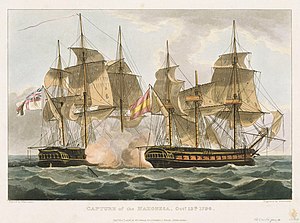 Print by Thomas Whitcombe depicting HMS Terpsichore capturing Mahonesa on 13 October 1796
| |
| History | |
|---|---|
| Name | HMS Terpsichore |
| Ordered | 29 July 1782 |
| Builder | James Betts, Mistleythorn |
| Laid down | November 1782 |
| Launched | 17 December 1785 |
| Completed | By November 1786 |
| Fate | Broken up in November 1830 |
| General characteristics | |
| Class and type | 32-gun Amazon-class fifth-rate frigate |
| Tons burthen | 6824⁄94 bm |
| Length |
|
| Beam | 35 ft 1+1⁄2 in (10.7 m) |
| Depth of hold | 12 ft 2 in (3.7 m) |
| Propulsion | Sails |
| Sail plan | Full-rigged ship |
| Complement | 220 |
| Armament |
|
HMS Terpsichore was a 32-gun Amazon-class fifth-rate frigate of the Royal Navy. She was built during the last years of the American War of Independence, but did not see action until the French Revolutionary Wars. She served during the French Revolutionary and Napoleonic Wars, in a career that spanned forty-five years.
Terpsichore was launched in 1785, but was not prepared for active service until the outbreak of the French Revolutionary Wars in 1793. She was initially sent to serve in the West Indies where in 1794 Captain Richard Bowen took command. Bowen commanded Terpsichore until his death in 1797, and several of her most memorable exploits occurred during his captaincy. Terpsichore served mostly in the Mediterranean, capturing three frigates, and in 1797 went as far as to attack the damaged Spanish first rate Santísima Trinidad, as she limped away from the Battle of Cape St Vincent. Santísima Trinidad mounted 136 guns to Terpsichore's 32, and was the largest warship in the world at time. Terpsichore inflicted several casualties, before abandoning the attack.
Terpsichore passed through several commanders after Bowen's death at Tenerife, and went out to the East Indies, where her last commander was Captain William Augustus Montagu. Montagu fought an action with a large French frigate in 1808, and though he was able to outfight her, he was not able to capture her. Terpsichore returned to Britain the following year, and spent the last years of the war laid up in ordinary. She survived in this state until 1830, when she was broken up.